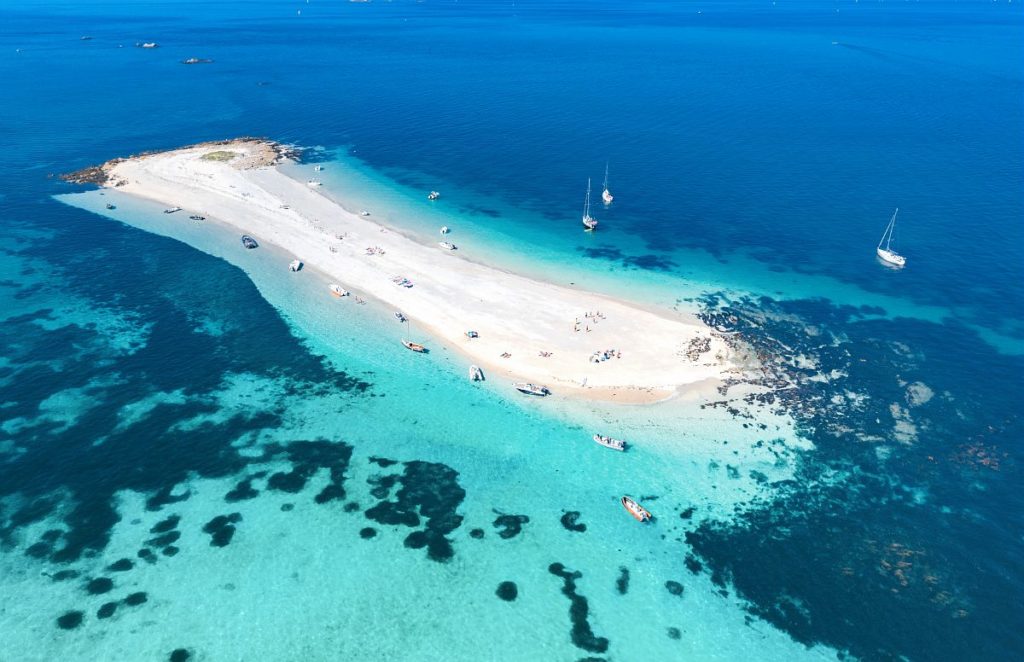
So that you can shine with well-founded half-knowledge before, during and after your holiday in Brittany, we have compiled the most important facts for you.
Brittany is an ancient region with an unusual and rich history. It all began millions of years ago on the primeval continent of “Armorica”. The towering “Armorican Massif”, part of Armorica at that time, with its very massive and very old rock, forms the geological bedrock of Brittany today. The clearest remnants of this period before the formation of Europe are the rocky coastal sections that fascinate the observer, especially in the Côtes-d’Armor.
Rocks also play an important role millions of years later. Around 6,000 years ago, settlers settled in Brittany. The first cattle breeders and farmers left megaliths, huge worked stones and rock formations in the landscape, which were later called menhirs or dolmens. What purpose these stones served is not clear. The people and culture disappeared, and in their place the Celts appeared in Brittany about 2,500 years ago.
The Celtic tribes ruled until the Romans advanced into the northwest of what is now France. The Celts resisted, but ultimately had to admit defeat. The Celtic language and culture perished under the victorious Romans. Almost simultaneously, new settlers appeared. Members of tribes from the British Isles brought Breton with them to Brittany.
In the early Middle Ages, a coherent Breton kingdom emerged for the first time. Independent Brittany went through various phases of stability and cohesion until the princes could no longer withstand pressure from their neighbours. Anne de Bretagne was the last ruler of an independent region; her marriages to two French kings initiated the final annexation to France.
Breton Independence
Even today, a sense of independence and autonomy is based on the historical roots. The most visible expression is the ubiquitous black and white flag, the “Gwenn ha du”. The stripes on the flag stand for the former duchies and bishoprics of Brittany. Numerous associations and initiatives try to preserve and promote the traditional symbols of Breton cultural identity, such as the Breton language, dances, music or traditional costumes
Apart from a minority, hardly anyone in Brittany wants independence from France. The time of radical excesses in the independence movement, with attacks on French state institutions, is long gone. Across Brittany, however, you can still see the lettering “BZH” or slogans for a referendum on Brittany’s independence on motorway bridges and walls. That there would actually be a majority in favour of secession from France in the event of a referendum can justifiably be doubted.
Breton (Brezhoneg)
Until the 20th century, there were still many Bretons who spoke only Breton. Today, Breton no longer plays a role in everyday communication. Decades of strict measures against Breton on the part of the authorities have led to the language being classified as threatened with extinction by UNESCO. It is estimated that around 200,000 to 300,000 people in Bretgane understand the Celtic language, the majority of whom are over 60 years old. The number of competent speakers is probably far below that. Precise figures are not possible; the French government does not collect data on the use of unofficial languages.
Breton is not traditionally spoken throughout Brittany. The centre is Finistère; in the eastern parts of Brittany, “Brezhoneg” never became established. Presumably, the settlers from southern England and Wales who brought Breton to mainland Europe from the 8th century onwards would not have understood today’s speakers. The current version is too closely based on French in melody and rhythm.
Brittany Attractions
The biggest attraction in Brittany is undoubtedly the coast. Between the sandy beaches of Normandy in the northeast and the milder, sunnier coast of the Loire region beyond Brittany’s southwestern border, some special stretches draw visitors in. The Côte de Granit Rose, the steep cliffs at the Pointe du Raz or the Mediterranean-like Gulf of Morbihan are hard to compare with coasts on other seas in the world.
No less fascinating are the more than 800 islands that reflect the many facets of Breton seascapes. Tidal islands such as Île Callot near Carantec, the storm-tossed island of Ouessant or the colourful Glénan Islands are special destinations that, despite their beauty, are off the beaten track.
Brittany is not only sea and coast. In the forests of Brocéliande, the Monts d’Arrée or the medieval towns around Rennes, visitors experience a different, no less interesting Brittany.
In contrast to regions in the rest of France, there are comparatively few sophisticated châteaux and stately manoirs from the Renaissance in Brittany. Italianate castles such as the Château de Kerjean in Finistère are among the exceptions. The Gothic and Romanesque eras characterise the buildings in Brittany. Medieval fans will enjoy towns like Dinan, monasteries like the Abbaye de Daoulas and churches like Saint-Thégonnec.
To list all the sights of Brittany would go beyond the scope of this article. Even making a selection is a challenge. La Bretonelle has taken on the task and formulated its personal top 10. Since we couldn’t (and didn’t want to!) decide on a ranking, we created an alphabetical list of the most beautiful places in Brittany:
- Archipel Glénan
- Cap Fréhel
- Huelgoat
- Île de Batz
- Saint-Malo
- Pointe du Raz
- Quiberon
- Crozon
- Rennes
- Perros-Guirec
Comité Régional du Tourisme de Bretagne | © Thibaut Poriel
